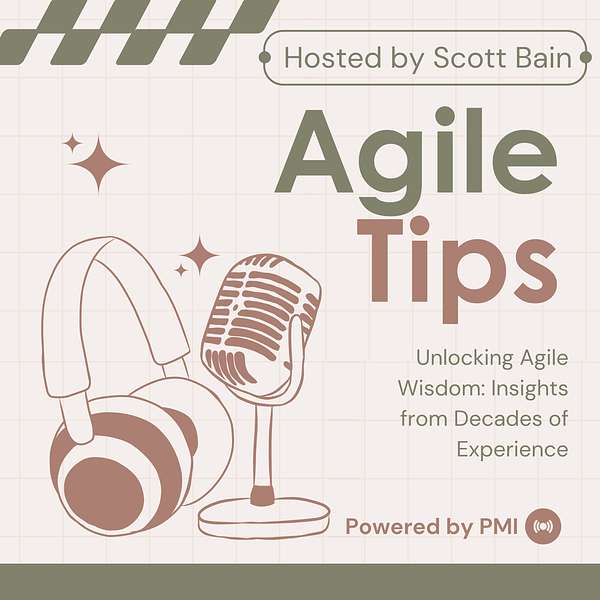
Agile Tips
Unlocking Agile Wisdom: Insights from Decades of Experience. Scott Bain is a 44+ year veteran of systems development.
Episodes
88 episodes
#86-Agile Culture
Agile transformation requires a shift in the culture of an organization if it can be expected to succeed. This week we'll examine what culture is, and what it means to alter it in anticipation of embracing agile.
•
4:39

#85-Agile Leadership
What is the best way to lead an agile team? Is the concept of a "leader" a different thing in an agile environment? These are the questions addressed in this episode.
•
3:58

#85-Common Misconceptions About Agile
This week I'll examine the five most common misunderstandings about agile processes. If you've experienced push-back, especially from your management, about going agile, this podcast should help.
•
4:07

#84-Agile Beyond Software
Is agile solely or primarily a software development paradigm? Not at all. This episode will give examples of agile being used in widely different areas of business, and suggest how you might try applying its principles to what you d...
•
3:36

#83-Measuring Agile Progress
How can we best measure the progress of an agile project? Getting this right is critical, and in some cases might be somewhat counter-intuitive. This episode is all about that.
•
5:04

#82-Lean to Agile
In this episode we wrap up our discussion of Lean by relating it to agile development processes.
•
4:20

#81-Lean Principle: Optimize The Whole
This week I'm covering the seventh principle of lean, which is to optimize the whole.
•
4:14

#80-Lean Principle: Respect People
Respecting the people in your organization has many implications regarding the way the environment is created, and the way the work within is conducted. This episode outlines how this respect is reflected in both manufacturing and in auto...
•
3:18

#79-Lean Principle: Deliver Fast
The idea of delivering fast has a very different meaning when you compare the manufacture of physical products to the process of developing a system to meet a business need. This episode will delve into those differences.
•
4:11

#78-Lean Principle: Deferring Commitment
Waiting until the "last responsible moment" to make critical decisions is important both in physical manufacturing and the creation of business automation. This week, I'll outline the concept and the differences that exist when applying t...
•
4:04

#77-Lean Principle: Create Knowledge
This week I will examine the principle "create knowledge" and how it influences both the way physical products are manufactured but in the creation of business automation. Along the way I wall introduce the process of Kaizen, and compare ...
•
4:24

#76-Lean Principle: Build Quality In
This week I'll delve into the concept of quality as a constant concern in project management, and use the Toyota Production System to illustrate what this means both in terms of building physical products, but also the creation of business auto...
•
3:46

#75-Lean Principle: Eliminate Waste
In part one of my series on Lean, I examine the concept of eliminating Muda, or waste. I will show this in the context of manufacturing and software development, to compare and contrast the two.
•
3:11

#74: Introduction to Lean
This will be the first in a series on Lean Manufacturing and Lean Software Development, which is a major enabled of agile processes.
•
3:19

#73-AI: The Future Of Systems Development
I conclude this series my summarizing my current views on AI and it's increasing role in the development of business automation.
•
3:12

#72-AI: The Business Context
In the episode I will reflect on what I have learned by interacting with the management of the corporations I teach for, regarding the thoughts, concerns, and plans around AI.
•
4:14

#71-AI: Scaling Our Effort
People fear being replaced by AI. Should they? This episode will examine why this concern may not be as founded as people think, at least when it comes to industries I am familiar with.
•
4:02

#70-AI: A Tool For Product Development
This episode will use software development as an example of how AI can be used to make the product development process more efficient, and less wasteful. This is an example which I believe could apply to any kind of product.
•
5:02

#69-Artifical Intelligence - Introduction
This podcast will kick off a series of episodes on AI, and my personal view of it.
•
3:33

#68-Shift left - Conclusions
This week I will wrap up the notion of Shift Left, and introduce the next topic for this podcast.
•
4:04

#67-Shift left - Detecting Defects During Analysis
The final "shift left" I will examine is the detection of defects during the planning process, specifically requirements analysis. It represents one of the most important and also most difficult challenges that face us when developing pro...
•
3:47

#66-Shift left - Detecting Defects During Design
In our continuing effort to shift the detection of defects and other mistakes to earlier and earlier phases in our development process, this week I'll discuss the role that design can play.
•
3:28

#65-Shift left - Detecting Defects During Implementation
This week we will examine how defects can be detected and sometimes even prevented during the implementation of the product as analyzed and designed in the previous phases.
•
3:57


